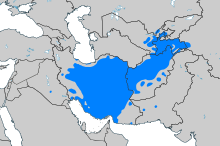Persian language
| Persian | |
|---|---|
| Farsi | |
| فارسی | |
 Farsi in Persian script (Nastaʿlīq style) | |
| Pronunciation | [fɒːɾˈsiː] |
| Native to | Iran[1] Afghanistan[1](as Dari) |
Native speakers | 60 million (2009)[2] (110 million total speakers)[2] |
Early forms | |
| Dialects | |
| Arabic (Persian alphabet) Cyrillic (Tajik alphabet) Hebrew script Persian Braille | |
| Official status | |
Official language in | |
Recognised minority language in | |
| Regulated by | Academy of Persian Language and Literature (Iran) Academy of Sciences of Afghanistan |
| Language codes | |
| ISO 639-1 | fa |
| ISO 639-2 | per (B) fas (T) |
| ISO 639-3 | fas – inclusive codeIndividual codes: pes – Western Persianprs – Eastern Persiantgk – Tajikiaiq – Aimaqbhh – Bukharichaz – Hazaragijpr – Dzhidiphv – Pahlavanideh – Dehwarijdt – Juhurittt – Caucasian Tat |
| Linguasphere | 58-AAC (Wider Persian) > 58-AAC-c (Central Persian) |
 Approximate extent of the Persian language area. Map includes all three dialects of Persian. | |
Persian, also called Farsi, is a Western Iranian language. It is the official language of Iran, Afghanistan and Tajikistan. It is also spoken by many people in Pakistan, Uzbekistan, Azerbaijan and other neighbouring countries and by immigrants from Central Asia in Russia. Persian was also taught as a second language in schools in Pakistan until 2006. In the past, many of those places were parts of the Persian Empire.
Persian has many dialects and is officially called Farsi in Iran, Dari and Farsi in Afghanistan and Tajiki in Tajikistan. The literary language of each country is a little different, but people from each country can understand one another when they have a conversation. It has words from French in Iran and many from Russian Tajikistan.
Alphabet
[change | change source]The Persian alphabet has the following letters:
ا ب پ ت ث ج چ ح خ د ذ ر ز ژ س ش ص ض ط ظ ع غ ف ق ک گ ل م ن و ه ی
The Persian alphabet used in Iran and Afghanistan is similar to the Arabic alphabet, but since Persian in a different family from Arabic, their vocabulary and grammar are very different. Since the 1930s, in the countries that were in the Soviet Union, like Tajikistan and Uzbekistan, Persian has been written in the Cyrillic alphabet, like Russian. Persian-speakers formerly used Pahlavi writing, changed to the Arabic alphabet, and added letters to fit their language.
History
[change | change source]Persian is a very old language, and linguists use names for three different versions of Persian that were used in three different times. Old Persian was spoken in the first Persian Empire, under the Achaemenid kings, including Cyrus and Darius the Great. The empire existed from the 6th century BC to the conquest of Alexander the Great. The second Persian empire was ruled by the Sassanian kings from the 2nd century AD until the Muslim conquest of Iran by the Arabs in the 7th century and spoke Middle Persian, or Pahlavi.
New or Modern Persian is spoken today and was first written down in the 9th century, during the Samanid Empire, which was the first Muslim Persian kingdom and was based in Central Asia. The earliest writers of New Persian included poets like Rudaki, and Ferdowsi, who wrote an epic, a very long poem, called the Shahname, translated as the Book of Kings in English. It has myths and historical stories from before the Arabs conquered Persia.
Many other famous writers in Persian language were poets too, a few being Saadi, Hafez, Rumi. The Persian language has been very important one for literature. After Arabic, it was the second most common written language in Muslim countries, especially in the East.
Sample
[change | change source]
|
|
|
|
Related pages
[change | change source]References
[change | change source]- ↑ 1.0 1.1 1.2 1.3 Samadi, Habibeh; Nick Perkins (2012). Martin Ball, David Crystal, Paul Fletcher (ed.). Assessing Grammar: The Languages of Lars. Multilingual Matters. p. 169. ISBN 978-1-84769-637-3.
{{cite book}}: CS1 maint: multiple names: editors list (link) - ↑ 2.0 2.1 2.2 2.3 2.4 2.5 Windfuhr, Gernot. The Iranian Languages. Routledge. 2009. p. 418.
